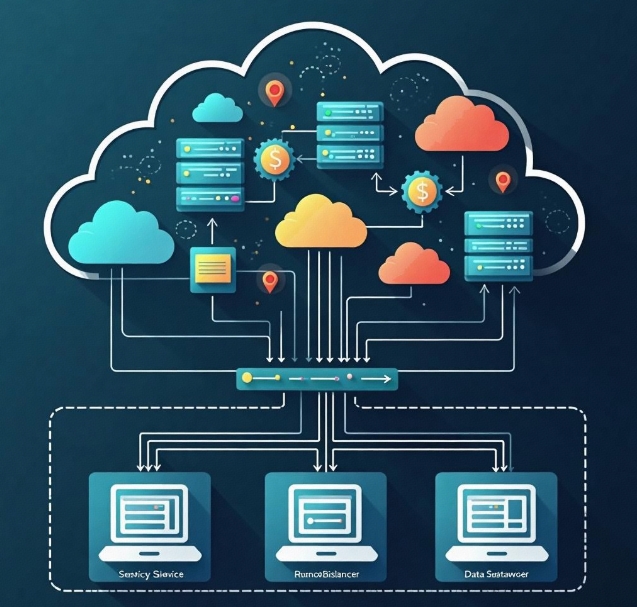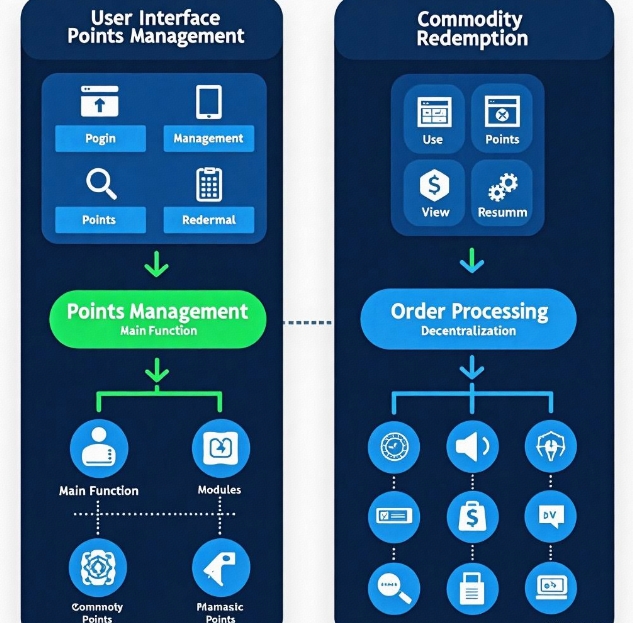How to Build an Efficient Points Mall System? Detailed Technical Architecture Explanation
- latest articles
- 1.DApp Development & Customization: Merging Diverse Market Needs with User Experience 2.Analysis of the Core Technical System in DApp Project Development 3.How to achieve cross-chain interoperability in Web3 projects? 4.How does the tokenization of points reconstruct the e-commerce ecosystem? 5.How to Set and Track Data Metrics for a Points Mall? 6.What is DApp Development? Core Concepts and Technical Analysis 7.Inventory of commonly used Web3 development tools and usage tips 8.Development of a Distribution System Integrated with Social E-commerce 9.Six Key Steps for Businesses to Build a Points Mall System 10.What is DApp Development? A Comprehensive Guide from Concept to Implementation
- Popular Articles
- 1.Future Trends and Technology Predictions for APP Development in 2025 2.Analysis of the DeFi Ecosystem: How Developers Can Participate in Decentralized Finance Innovation 3.From Zero to One: How PI Mall Revolutionizes the Traditional E-commerce Model 4.DAPP Development | Best Practices for Professional Customization and Rapid Launch 5.Recommended by the Web3 developer community: the most noteworthy forums and resources 6.How to Develop a Successful Douyin Mini Program: Technical Architecture and Best Practices 7.From Cloud Computing to Computing Power Leasing: Building a Flexible and Scalable Computing Resource Platform 8.Shared Bike System APP: The Convenient Choice in the Era of Smart Travel 9.How to Create a Successful Dating App: From Needs Analysis to User Experience Design 10.From Design to Development: The Complete Process of Bringing an APP Idea to Life
With the continuous development of the e-commerce industry, points malls, as a means to effectively enhance user stickiness and activity, have gradually become a key component in corporate digital transformation. Through points malls, companies can not only improve the user shopping experience but also stimulate purchasing behavior through point redemption incentive mechanisms. However, building an efficient points mall system requires consideration of multiple aspects of technical architecture design to ensure high performance, scalability, and maintainability.
This article will delve into how to build an efficient points mall system from a technical architecture perspective, covering system architecture design, core technology selection, system module division, database design, and security.
I. Overview of the Points Mall System
A points mall system is an e-commerce platform based on redeeming goods with points. Users earn points by purchasing products or participating in activities, which can then be used to redeem goods, services, or coupons in the mall. A points mall is not just a simple shopping platform; it also includes complex business processes such as points management, points acquisition, points redemption, and order management.
An efficient points mall system typically has the following characteristics:
High Concurrency Handling Capability: During promotional events or holidays, the system needs to handle a large number of concurrent user requests while maintaining stability.
Data Consistency: Ensures data consistency during points acquisition and redemption to prevent errors or redemption failures.
Flexible Points Rules: Supports various points acquisition and redemption methods, such as redeeming goods with points, exchanging points for coupons, and using points for cash discounts.
Good Scalability: As the business grows, the system should have good scalability to easily add new points rules, product categories, or payment methods.
II. Technical Architecture Design of the Points Mall System
An efficient points mall system must have a reasonable technical architecture design to maintain high availability, stability, and performance under large-scale user access. The following are key points to consider in the technical architecture design when building a points mall system.
1. Layered System Architecture Design
The system architecture can be divided into multiple layers based on functional modules, typically including the following layers:
Frontend Presentation Layer: Responsible for displaying the user interface, usually a web or app client. Users interact with the mall through the frontend to view products, points, orders, and perform redemption operations.
API Gateway Layer: This layer handles data interaction with the frontend, provides unified API interfaces, and is responsible for request routing and load balancing. The API gateway design should have efficient request forwarding and security protection capabilities.
Business Logic Layer: This layer handles all business logic, such as points calculation, points acquisition and redemption, and order processing. The business logic layer is the core of the system, managing various user behaviors and system operations.
Data Storage Layer: The data storage layer is mainly used for persistently storing various system data, including user information, product information, points records, and order records. A combination of relational and non-relational databases is typically used to meet storage needs in different scenarios.
2. Microservices Architecture
As business expands, monolithic architectures may face performance bottlenecks and maintainability issues. Microservices architecture effectively enhances system scalability and flexibility by splitting business logic into multiple small service modules. Each microservice is responsible for an independent business module, such as points management, product management, and order management.
Advantages of microservices architecture include:
Flexible Scaling: Each service module can be scaled independently based on demand, avoiding the "single point of bottleneck" issue in monolithic architectures.
High Availability: Microservices are independent of each other; even if one service fails, others can continue to operate, ensuring high system availability.
Rapid Iteration: Different microservices can be developed and deployed independently, allowing teams to work in parallel and improving development efficiency.
3. Distributed System
To handle large-scale user access, the points mall system needs to support a distributed architecture. Distributed systems allocate multiple computing resources across different nodes, providing unified services through network connections and coordination.
Designing a distributed system requires consideration of the following aspects:
Load Balancing: Distributes user requests evenly across multiple servers through a load balancer to prevent any single server from becoming overloaded and causing performance degradation.
Data Sharding: For large volumes of data, data sharding technology is used to distribute data across multiple database nodes, improving read and write performance.
Distributed Caching: Reduces database access pressure and speeds up data retrieval by using distributed caching (e.g., Redis, Memcached).
III. Core Technology Selection for the Points Mall System
Choosing the right technology stack is crucial when building a points mall system. Below are some key technology selection recommendations:
1. Frontend Technologies
Frontend technology selection should consider user experience and response speed. Common frontend frameworks include:
React: A declarative, efficient, and flexible JavaScript library for building user interfaces. It is particularly suitable for building dynamically updated single-page applications and provides fast page rendering.
Vue.js: A progressive JavaScript framework that is easy to learn, suitable for small to medium-sized projects, and efficient in interacting with the backend.
HTML5, CSS3, and JavaScript: These are foundational technologies for building frontend applications. HTML5 and CSS3 provide rich UI design capabilities, while JavaScript implements the interaction logic between the frontend and backend.
2. Backend Technologies
Backend technology stack selection should consider system high concurrency, data consistency, and scalability. Common technologies include:
Spring Boot: An open-source Java development framework suitable for microservices architecture, helping developers quickly build, deploy, and maintain backend services.
Node.js: Suitable for handling high-concurrency requests, based on an event-driven, non-blocking I/O model, making it ideal for developing applications with high real-time requirements.
Go Language: An efficient programming language with excellent concurrency performance, very suitable for developing distributed systems and microservices.
3. Database Technologies
Database technology selection determines system data storage and access performance. Common database technologies include:
MySQL/PostgreSQL: These relational databases are widely used in e-commerce systems, supporting transaction management, data consistency, and complex queries.
MongoDB: A non-relational database suitable for storing unstructured data, capable of flexibly handling high-frequency data operations.
Redis: A high-performance distributed caching database widely used for caching hotspot data, session management, etc., significantly improving system response speed.
4. Message Queue Technologies
To ensure high availability and high throughput of the points mall system, message queue technology is widely used for asynchronous processing and decoupling operations. Common message queue technologies include:
RabbitMQ: An efficient message queue middleware suitable for asynchronous message passing in distributed systems.
Kafka: A distributed stream processing platform particularly suitable for handling large-scale data streams and logs, supporting high-throughput real-time data transmission.
IV. Core Module Design of the Points Mall System
A complete points mall system typically includes multiple core modules that interact with each other via APIs. The following are design points for several core modules.
1. Points Management Module
The points management module is one of the core components of the system, responsible for points acquisition, consumption, and query functions. Points can be acquired by purchasing products, participating in activities, or checking in, while points consumption is achieved by redeeming products or coupons.
The system needs to provide flexible points rule management functions, allowing configuration of different points acquisition and redemption strategies, such as:
Setting different point rewards based on product types.
Holding regular points lottery activities to increase user engagement.
Setting points expiration mechanisms to prevent system data bloat from unused points over time.
2. Product Management Module
The product management module is responsible for managing product information in the points mall, including product names, prices, stock, and points redemption ratios. Mall products are not limited to physical goods; they can also include virtual goods, coupons, or services.
The product management module needs to support product listing, delisting, inventory management, and price adjustments, while integrating closely with the points system to ensure accurate points redemption ratios for products.
3. Order Management Module
The order management module handles user order requests, including order generation, order status queries, payment processing, and order cancellations. The order system needs to interface with the points system and payment system to ensure that points and payment operations are completed smoothly when users redeem products.
4. User Management Module
The user management module is responsible for managing user information, including user registration, login, points records, and order records. The system needs to provide user authentication and authorization functions to ensure the security of user identity information in the mall.
V. System Security Design
The points mall system involves a large amount of user data and payment information, making system security very important. The following are some common security design measures:
Data Encryption: All sensitive user data, such as passwords and payment information, must be encrypted during storage and transmission to prevent data leaks.
SQL Injection Prevention: The system should use prepared statements or ORM frameworks to avoid SQL injection attacks.
DDoS Protection: Use CDN, API gateways, and firewalls to prevent Distributed Denial of Service (DDoS) attacks.
VI. Summary
Building an efficient points mall system is not only a technical challenge but also requires comprehensive consideration of user needs, business logic, and system performance. Through reasonable technical architecture design, optimization of core modules, and rigorous security strategies, it is possible to provide users with a smooth, reliable, and secure points mall experience, enhancing user engagement and business benefits for the enterprise.
-

How does the tokenization of points reconstruct the e-commerce ecosystem?
With the continuous advancement of internet technology and the gradual prolifera···
-

How to Set and Track Data Metrics for a Points Mall?
With the rapid development of the e-commerce industry, points malls, as a common···
-

Development of a Distribution System Integrated with Social E-commerce
With the rapid development of internet technology, the e-commerce industry has e···

 Blockchain
Blockchain












